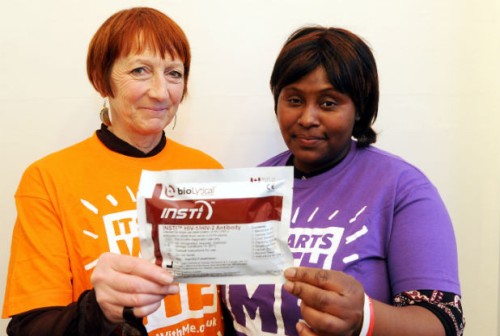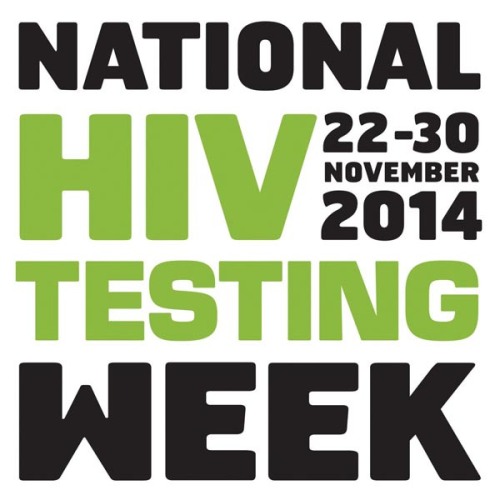
“I remember not getting out of bed other than to use the loo. My friend had to stay with me just to make sure I was eating,” says Niyi Maximus Crown, a 25-year-old man who was diagnosed HIV positive in December 2011. “I didn’t even recognize my own thinking voice. I felt like I was going to be single for the rest of my life. The feelings of worthlessness made me angry and I started to hate myself.”
Last week, Public Health England (PHE) released its latest report on HIV. “In the UK there are 107,800 people living with HIV,” says Eleanor Briggs, Assistant Director of Policy and Campaigns at National AIDS Trust. In London, almost one in eight gay and bisexual men are HIV positive. Based on the stats from PHE, Briggs adds, “We can say about a third of people living with HIV infection, both diagnosed and undiagnosed, were resident in London.”
What’s more frightening is that PHE estimates that 24 percent of the people in the UK with HIV are currently undiagnosed.
Brandon Wardell Is a 22-Year-Old Comic Who’s Already Done an Album with Bob Odenkirk
Early diagnosis of HIV is crucial. Briggs states that a late diagnosis can mean treatment becomes less effective, reducing a person’s lifespan. Medication also helps stop the spread of HIV by lowering the amount of HIV virus in a positive person to undetectable levels so they are unlikely to pass it on.
And yet few people are talking honestly about HIV. In terms of everyday knowledge on the gay scene, HIV exists somewhere in limbo between the grim tombstone adverts of the 80s, statistics that get bounced around annually from numerous health organizations and the raw realities of chemsex-fuelled bareback sessions. The subject usually makes an appearance in the media once a year when World AIDS Day rolls around. A leading HIV consultant told the BBC that there’s a “complete lack of awareness” of the risks among many gay men in the UK.
As gay venues up and down the country prepare to mark World Aids Day (on December 1) with fundraising events for various LGBT charities, though, how many people do you know are comfortable with talking openly about being HIV positive? Do you even know anyone that’s openly HIV positive?
The truth is that, as a community, we still drive people who live with HIV into the closet. It’s not surprising that most gay men feel they want to keep their status private. Many struggled during their lives to come out as gay to their friends, families or work colleagues, and they may not even be out in all aspects of their lives. Having to then deal with the stigma that still exists around being HIV positive is akin to having to deal with a second coming out and, once again, another round of judgement and shame.
A few HIV negative people share their thoughts. “If you get HIV from unprotected sex you deserve it,” said one. Many might privately agree with him. But does that mean they deserve to feel forever alienated by society?
Niyi is better known in London’s gay clubs as Maximus Crown. He is one of the only DJs that is publicly out about being HIV positive, which is a big deal. The UK gay scene has very few openly HIV positive DJs, drag queens or promoters. But Niyi didn’t really have the choice of whether he should put his status out there—his best friend at the time decided to go public with it on Facebook for him.
“My best friend stayed with me every day to make sure that I wasn’t alone, didn’t starve or try and kill myself,” Niyi recalls. “Six months later I decided to distance myself from him because I started to notice things about our friendship that I wasn’t OK with. To get back at me he went onto the Facebook event page for a party I was booked to DJ at and posted a series of comments about me being HIV positive.”
The comments included accusations that Niyi had been having unprotected sex while aware he was HIV positive. “When it happened I wasn’t angry, I just wanted to log out of the universe. If I could have closed my eyes and stopped existing I would have, but it forced me to own my status, which in turn made me more comfortable discussing it publicly.”
If you are old enough to remember the campaigns of the 80s, then safer sex and the issues around HIV would have been drummed into your consciousness. But with the advent of combination therapy and the dramatic development of antiretroviral drugs that revolutionized care over the last fifteen years, AIDS-related deaths dropped substantially. Between 2001 and 2011, the rate of new infections dropped by 20 percent.
As the number of deaths fell, though, so too did government resources that educated people about HIV. Schools barely touched on the subject. To most people, it was seen as a disease that only affected poorer countries. It’s no wonder that the number of infections in young people has risen comparatively steeply compared to other age groups. As the United Nations Population Fund say, young people remain at the centre of the HIV epidemic in terms of rates of infection, vulnerability, impact, and potential for change. The young have grown up in a world changed by AIDS, but so many still lack the correct knowledge about how to prevent HIV infection.
For many recently infected guys, getting their head around living with HIV is one of the biggest challenges.
James Hanson-McCormick, 24, who was 18 when he was diagnosed with HIV said “I had no idea what HIV was or how it was contracted. I have had six years to think about my status, and not a single day goes by without me thinking about it. It’s so hard. I wish I knew more [then], I wish I had been better educated and that I knew enough to try and prevent it happening.”
It might sound naïve, but James isn’t alone in his experience. Luke Alexander is from Oldbury, a small town outside Birmingham, and was diagnosed HIV positive in June 2013. He was 18. “If I was in a sexual relationship with a guy when I was 15 or 16 it was monogamous,” he tells me. “When I hit 18 I treated myself to a fancy phone and discovered these apps and clubs. You’re new to everything and people say ‘download this’ and you find people want to hook up with you. It’s validation. You become quite promiscuous.”
Luke’s candidness took me aback. “I became incredibly egotistical and quite narcissistic,” he admits. “Add drugs and alcohol into the equation and it becomes quite a habit. One thing led to another and I didn’t take any precautions.”
Will Harris, Head of Media for Terrence Higgins Trust, says that while research shows that most gay men use condoms most of the time, it only takes one instance of unprotected sex for HIV to be passed on. “Condom use has to be consistent… It’s basic human nature to under-estimate risk, so our community needs to keep finding ways to reinforce the message that ‘He looks fine, it’ll probably be OK’ won’t give you the protection that a condom will.”
Earlier this year, Luke made headlines when he went on ITV’s This Morning to discuss his HIV status. “I never heard anything about HIV in school,” he said. “You can become a bit reckless when you come of age, but it’s far worse if you have no basis of knowledge to refer to.”
Like James, Luke’s sex and relationship education in school was virtually non-existent. “It lasted a few hours. If people weren’t there, they didn’t receive it. While they stressed the importance of contraception, it was for pregnancy. When I asked about anal sex, they said, ‘We don’t recommend it.’ I felt embarrassed. I just wanted to hear their perspective.”
Harris agrees that the education system has failed in this regard, saying that:
“Young gay men are generally frozen out by the current approach to sex education in schools.”
“The past is the past, though, and you can’t change that,” James reasons. “The great thing now is I’m healthy and happy. I’ve been on meds for five years now and doing so well. My health, in general, is alright.”
But living with HIV isn’t just about monitoring your physical wellbeing. The emotional strain of the constant check-ups and coming to terms with the virus can also present its own psychological strain.”Physically I’m fine,” James says. “I do suffer with depression, but that’s down to several things—not just my HIV. Sometimes it’s difficult juggling lots of meds every day. Often my depression gets bad and tells me I’m worthless and to not take it. But I have faith in medicine that one day there will be a cure.” His biggest wish is more altruistic still: “More knowledge and understanding around HIV and AIDS.”
For many recently infected guys, getting their head around living with HIV is one of the biggest challenges. Stigma is a major issue.
“Robert,” 29, (not his real name), has been HIV positive since 2007. A casual partner sexually assaulted him when he was passed out after a heavy drugs session. Only his closest friends and immediate family are aware of his status. He puts this down to the assumptions that people make about those who are positive. “It’s not the fact that it’s an unattractive quality [to be HIV positive], it’s that people think you had a choice. You hear a lot about bareback parties and people who think that those who have a lot of condom-less casual sex ‘deserve’ to get HIV. I don’t judge anybody but I don’t want to be put in that category. I’m not ashamed of being HIV positive, but it does affect how people perceive you if they don’t know you.”
Robert has told around ten partners about his status when they’ve asked about barebacking. “I don’t have unprotected sex unless we are both aware of our status,” he says. Even so, he says it’s still common for HIV positive guys to be afraid to disclose their status to others in the same position: “I’ve even met positive guys who I’ve been honest with, but they have lied about being positive because they don’t want to say they are.”
It’s upsetting to think that we are forcing so many thousands of gay men into a situation where they feel alienated by their own community. It takes a strong person to rise up against a tide of possible condemnation and be among the first to speak up.
Luke lost friends after going public about his diagnosis. People stopped answering his calls. He believes it was because they were afraid to be associated with somebody that was openly HIV positive. Similarly, when he confided in a friend about his status, she was more concerned that she’d shared his wine glass than how Luke was feeling. (Incidentally, if you labor under similar misconceptions, HIV cannot and will not be spread by sharing glasses.)
Sadly, despite it now being considered to be a very manageable long-term health condition, HIV is still widely misunderstood. “You can sit on a park bench and talk for two hours with someone about your diabetes,” Luke says. “But you can’t do that with HIV because you’ll often get a look of fear and shock.”
Niyi eventually reached a point when he had enough of feeling ashamed. “I woke up one day and was like, life isn’t always going to be easy. Self-pity isn’t fierce and it isn’t fun. Doing things and being around people that encouraged me to feel good about myself was such a big help.”
There is one hurdle that remains for him, though, and that’s relationships. He’s been single for seven years. “The thought of being rejected by a guy because of it terrifies me. I feel that it will always hold me back until I am able to get past that final fear.”
James has been luckier in love. He met his boyfriend 18 months ago and they married last August.
Niyi, Luke and James are heroes! They have decided that it’s time to challenge the stigma that looms around HIV for no other reason than people are not talking about an issue that affects us all. The education system is broken, so they’ve taken it upon themselves to speak out about it. They have taken a situation that could have stripped them completely, that could, if they let it, absolutely define them, but instead have turned it into something powerful.
As his fears subsided, Luke was inspired by another HIV activist and started blogging about his experience. “It got a lot of attention. I wanted to help people understand and it was a feeling of empowerment. The good reactions that followed confirmed it was the right thing to do,” he says. He now also writes monthly about the subject for Gay Times.
Niyi agrees. “There are so many people suffering unnecessarily because they feel that being HIV nullifies everything good about who they are, but it really doesn’t. Everybody deserves to wake up feeling like they are of value and if all I have to do is talk about my situation in order for people to see that, then that’s what I will do. People need to know that someone’s HIV status is not an indication of what kind of person they are.”
Story via Vice
STAY UPDATED




















